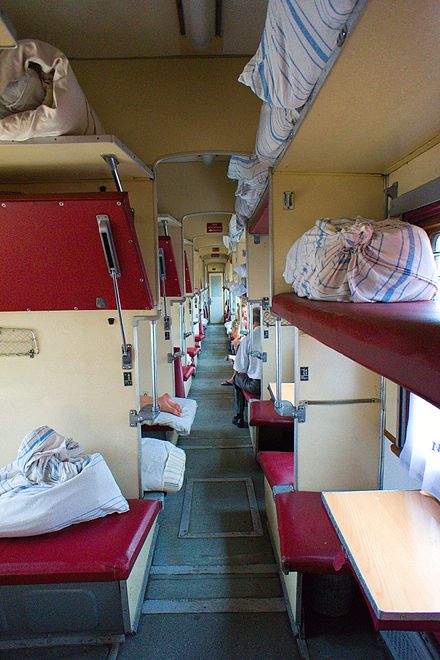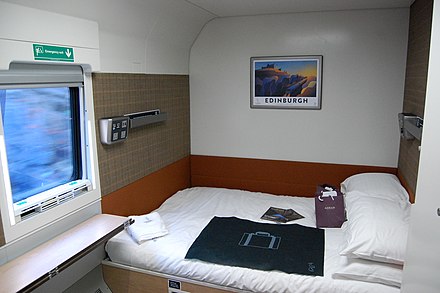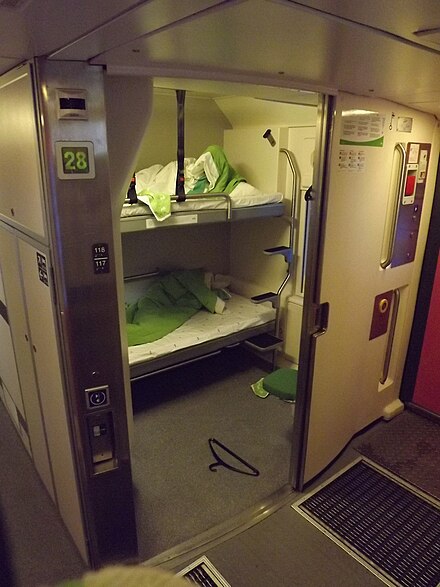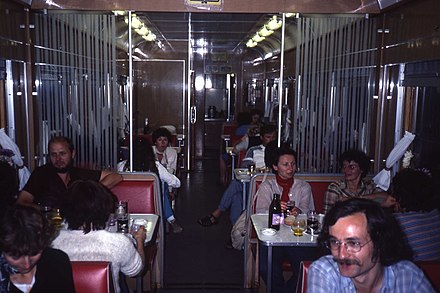Sleeper trains
Sleeper trains

Sleeper trains combine travelling with a place to sleep. Before the breakthrough of air travel, sleeper trains were the preferred way of travelling long distances overland. A few trains, including the "Orient Express" which used to run from Paris to Istanbul, became famous through film and literature. The rise of aviation (now cheaper than many long train journeys) and high speed trains (slashing travel times), and financial concerns on the part of the operators, have made many sleeper services disappear, but they are still an important part of the railway network in a number of countries.
New sleeper services have been introduced for leisure travellers. These offer a level of comfort and sightseeing not possible while flying. Tourist railways may bring them back for nostalgia. Many travellers prefer rail over flying for environmental reasons. Sleeper trains are also the cheapest or most practical way to reach certain places.
Understand

Sleeper trains often have different categories of accommodation. The exact details vary from train to train, but will typically be one or more of the following, at different prices:
- Sleeper cabins These are often one or two (bunk) berth cabins, and are usually sold for exclusive use, similar to a hotel room. However a cabin will feel very cramped compared to a hotel room, and often has no or very limited washing facilities, such as just a sink.
- Couchette These are bunks in a shared compartment or carriage. In Europe, couchettes are usually in compartments with 6 bunk beds.
- Seats These can be the same seats as in a regular daytime train or they might be different, perhaps fully reclining like in airline business class. These may be intended primarily for those travelling shorter distances, or be offered as a budget option. With some rail passes you can travel in a seat on a sleeper train with no supplement.
On many trains – especially those that run more than one night – cabins have a "day" and "night" mode, with beds either converted to seating or folded away in the day mode: the bunks are folded up, with the lowest bunk forming a seat. You will usually get help from the train staff in converting your cabin to night mode.
Usually a carriage of couchettes or sleeper cabins will have an attendant who will check your ticket and show you to your berth. They may even provide a wake up service. If the train crosses an international border, the attendant may take your passport to show to officials, such as often in Europe, or you may be woken at the border. If you are in a seat you may be woken for ticket checks as well as border crossings. In the Schengen area border crossings may not be noticeable in any way, but there are still often controls on international trains.
A few sleeper train services also carry cars, such as the ones between the south and Lapland in Finland. This allows using your own car (or a car rented somewhere with a good supply) while avoiding sitting behind the wheel for all of a day.
The night train entered into the 21st century in a decline – high speed rail on one side and low cost air travel on the other were increasingly calling the business model into question. As a result of the rise of high-speed rail, sleeper trains have become obsolete on many routes in Japan and Western Europe, thus making them an increasingly rare breed. Europe – long a bastion of the night train – was changing over its railroads from cooperating quasi state agencies to competing private companies and running a train across several borders suddenly became more of a headache than it had ever been in peacetime. In China high-speed rail has also become more common, but the vast size of the country means that sleeper service is available on some longer high-speed routes as well, and like in Vietnam, Thailand and India, the alternatives to sleeper trains are too expensive for many people.
When Deutsche Bahn, once the biggest operator of night trains on the continent, wound down that part of their business, many foresaw only doom and gloom, but all was not lost: the Austrian railway (ÖBB) bought up the younger parts of the rolling stock DB had used (serendipitously DB had younger cars in exactly those categories in which ÖBB had most need for replacements) and offered service both on routes into or through Austria and routes without any connection to the small alpine republic. The unexpected success of the Austrian sleeper trains and increasing calls for "greener" transportation options – including the well publicized trips of Greta Thunberg by train across half of Europe – led to increasing calls for more night train service. The European Union declared their intention to help union-wide sleeper trains, several national governments announced their willingness to pick up any potential operating losses of proposed new routes and private operators saw their niche here and there offering their own services. Even the Covid-19 crisis did not throw a wrench into the growth plans as families could book an entire compartment and thus reduce infection risk on their trips to and from a much earned vacation in the "covid summer".
Rail systems with sleeper trains

Sleeper trains normally appear on long journeys which cannot realistically be completed in a single day.
Africa
- Egypt (Alexandria–Cairo–Luxor–Aswan)
- Morocco (to Marrakesh)
- South Africa (several routes)
- Namibia
- Tanzania
Americas
- Argentina has the only sleeper services in South America – trains from Buenos Aires to Bahía Blanca, Tucuman and Córdoba
- Canada has several sleeper services are available on VIR Rail Canada's longer routes, such as The Canadian from Toronto to Vancouver and The Ocean from Montreal to Halifax. Don't expect to see them on the Windsor-Quebec corridor, as that trip can be completed in a day and frequent short-haul day service is offered instead.
- United States – Amtrak, the only intercity passenger train operator, offers sleeper service on most of its longer routes, which is a great way of seeing the US without a car.
Asia

- China has the only high-speed sleeper service, and most non-high-speed intercity rail service are in the form of sleeper trains. Some longer daytime high-speed routes, such as the Hong Kong-Beijing and Hong Kong-Shanghai routes also feature business class with fully-reclining seats. Conventional sleeper services are still available on many routes, but often complemented by high speed connections that do the trip in a single day. The Beijing–Lhasa route is one of the most notable for its journey through high-altitude areas, and its use of oxygen-enriched air to help passengers cope with the higher altitude.
- Japan still has one remaining sleeper service, with other sleeper services having been made obsolete by the high-speed Shinkansen.
- India also offers sleeper service in different classes (levels of comfort at different price points) for their longer journeys.
- Indonesia eksekutif luxury class coach has seats like business-class plane seats. Also, the rented coach kereta wisata has a bedroom.
- Iran
- Malaysia (jungle line only)
- Russia has sleeper trains, especially on the Trans-Siberian Railway. Russian Railways also runs sleepers westward for people willing to spend more than comparable plane tickets would cost.
- Thailand has a number of lines from Bangkok, including to Chiang Mai and to Pedang Basar, onward to Kuala Lumpur, and Singapore
- Turkey: nighttime services always have a sleeper car attached, including the popular lines Istanbul to Ankara (the Ankara Express), and Ankara to Kars in the far northeast (the Eastern Express).
- Vietnam has sleepers on long-distance trains, including the "Reunification Express" between Hanoi and Ho Chi Minh City.
Australia
- Australia – Both transcontinental routes operated by Great Southern Rail offer sleeper service. These cater mostly to leisure travellers with a lot of time and money on their hands. Sleepers are also available on NSW Trainlink's overnight services from Sydney to Melbourne and Brisbane, while Queensland Rail's Spirit of the Outback from Brisbane to Longreach also features sleeper cabin, and its flagship_Spirit of Queensland_ from Brisbane to Cairns offers lie-flat seats similar to those in international long-haul business class on airlines.
Europe


Europe invented the concept, and legendary routes used to criss-cross the continent. Many have been shut down, and many others are under threat. There is still quite good coverage though, especially in the east and in the Nordic countries.
- Austrian Railways (ÖBB) has taken up the mantle of Deutsche Bahn (which used to be the main operator), running a fairly extensive network throughout Central Europe with a focus on the German-speaking countries and former Austria-Hungary under the brand Nightjet. Nightjet is bucking the trend of reducing sleeper services and is instead expanding its network.
- Finland has sleeper trains from Helsinki and Turku in the south to Lapland. Cars can be taken on the trains between some stations. The sleeper train to Moscow has been suspended.
- France only has four domestic sleeper (Intercités de Nuit) train routes left, from Paris to Briançon, Rodez, Latour-de-Carol (bus service to Andorra), and Toulouse.
- Norway has sleeper services from Oslo to Bergen, Kristiansand, Trondheim and Bodø, with tickets for sleeper compartments or for seats (with blanket and earplugs included). Narvik has a sleeper train from Sweden, from Stockholm via Kiruna.
- There are several domestic night trains in Poland.
- Russia's long distance trains are all sleeper trains, which is no surprise given the long distances in the country. Especially famous is the Trans-Siberian Railway. Russian Railways also runs sleepers westward for people willing to spend more than comparable plane tickets would cost.
- Spain has a few domestic routes. Most of the erstwhile "Trenhotel" network has been slashed, especially with regards to routes to France.
- Sweden has a few sleeper services, one of which continues to Narvik in Norway. The Swedish government called for an expansion of sleeper services in and out of Sweden with a government subsidy in 2019.
- In the United Kingdom, there are three sleeper services: two between London and Scotland, and one between London and Cornwall.
Booking
Unlike daytime trains, sleepers usually must be booked in advance. For high-demand days, the sleepers may sell out quickly.
While most railways allow you to book sleeper trains the same way you book any regular train (e.g. at ticket counters, online or via phone), you often have to get a seat – or in this case berth – reservation, which often includes the surcharge for sleeper service. Often passes, like Interrail, only cover the price for a "standard seat" in second class and the sleeper surcharge has to be paid on top of that.
Accommodation is usually sold on a first-come, first-served basis and you may get bargains by booking early or by getting an "upgrade" when already on the train if berths are available.
Sleeper trains often run through several countries. While the operator needs agreements with the national railways, these do not necessarily handle bookings. Check what entity to contact for tickets. In some cases tickets are sold through different services to different prices.
Eat

Most sleeper trains also have a dining car, while almost all of the others offer food at your cabin. However the dining car can have limited supplies which may run out if the train is running late, so you may wish to bring some food with you as a backup. Many train companies post their menus (including prices) on-line and you can usually rely on these being at least somewhat accurate. However serving sizes are often smaller and prices often higher than comparable food outside a train. Depending on the route and railway, breakfast or even all meals may be included in premium fares or all sleeper fares.
Drink
The tap water on a train is usually not drinkable – in Europe this is usually clearly indicated either by a pictogram or in words (usually in more than one language), in other places it might be apparent from context. You may want to bring some bottled water with you, as it will be cheaper to buy this in the station (or a regular supermarket) than on the train. In the rare cases of catastrophic air conditioning failure, you might get free drinks to ease the heat. But as sleeper trains travel mostly at night, this is rather unlikely.
In some countries you are not allowed to bring your own alcohol, as the train is a "licensed premises" like a pub. On some trains all alcohol is prohibited, but in most countries this rule only affects commuter trains and has not yet spread to sleepers. However, people in the neighbouring cabins may want to get a good night's sleep, and some may have an early morning; don't have loud parties.
Sleep
While some people love the rumbling and bumbling of the train that "rocks them to sleep" others hate the noise and cannot sleep. While some countries invest a lot in their rail networks to reduce bumps, in other countries you are definitely in for a bumpy ride. Your mileage as to sleeping may certainly vary. In bunk accommodation that is shared with several other people snoring may also be a problem, so bring earplugs. Sleeping in a regular seat, even if it is reclining, is certainly not all that comfortable, but a lot of budget conscious travellers have done so in the past and regular seats are still available on most trains with sleepers, sometimes for quite affordable rates indeed, compared to more comfortable options.
Cope
While en suite bathrooms are uncommon, many sleeper trains have shared showers, at least in Europe. As there will certainly be queues in the morning, you might want to plan when to go. The showers are usually cramped, at least the en suite ones.